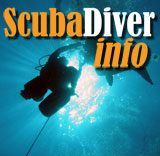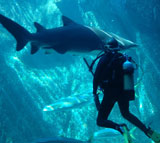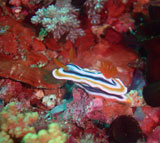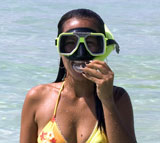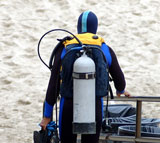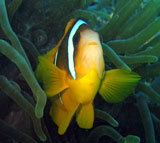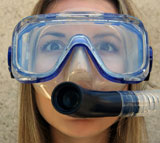Scuba Cylinders
by Conrad H. Blickenstorfer
As everyone (well, almost everyone) knows, "SCUBA" stands for "Self-Contained Underwater Breathing Apparatus." Without air we can't breathe, which means the compressed air tank that supplies you with air as long as you're underwater is of central importance. Air means life, and the container that carries your air therefore means life, which means it has to be absolutely fail-safe.

That's why scuba cylinders--which are also referred to as "tanks" or "bottles"--must not only be of high quality, but they are also subject to
periodic inspection and testing. Each tank has a series of codes on it and each has inspection and testing stickers. If those are out of date, no responsible, reputable dive shop will refill the tank. As you can see, diving certification agencies take no chances. Imagine if gas stations would refuse to let you fill up your tank if the inspection sticker on your car is expired; that's how strict diving regulations are.
While all Scuba tanks serve the same purpose, they come in various shapes, sizes, materials, colors, and pressure ratings. And while most recreational divers carry a single bottle, there are also twin tanks that share a single regulator or even feed separate regulators for more advanced diving. In some diving documentaries you may even see futuristic looking backpacks that contain specially designed scuba cylinders. That looks great but probably doesn't work any better than an ordinary tank.
Scuba tanks come in various sizes, usually holding between 50 and 150 cu-ft of compressed air, though some bottles can hold as little as 25 cu-ft. They have different shapes. Some are tall and thin, others short and squat. Many hobby divers don't own their own tanks and rent them instead whenever they go diving, but if you do buy a tank, length is important as it should fit your body size. Fortunately, tank fittings are standardized so that all rental tanks will be compatible with your other dive gear. Rental tanks can usually hold 80 cu-ft at a rated pressure of 3,000 psi. Divers refer to tanks by their capacity, so a typical rental tank is called an "Eighty."
When you get started with scuba and take your first open water course, the
instructor will likely assign a smallish 65 cu-ft tank at first. If you
think that's big, you're in for a surprise once you get to the larger tanks!
Picking the right tank is just as important to enjoying scuba diving as picking the right mask, fins and other gear, if not more so. A tank that is too small or too large, doesn't fit well, or has annoying buoyancy characteristics can turn effortless floating into a struggle, so choose wisely.
But now lets take a closer look at the compressed air tanks used for scuba diving.
What are Scuba tanks made of?
Either steel or aluminum. Each has its advantages and disadvantages.
Steel is harder than aluminum and therefore doesn't dent or get otherwise damaged as easily. Steel has also a higher specific weight than aluminum, which means divers using steel tanks need to carry less weight on their belts or suits.
However, steel is prone to rusting--an unfortunate tendency in a piece of equipment that is
often exposed to far more oxygen than uncompressed air carries. After all, rust is nothing more than oxidation
of iron atoms. And since the air inside a scuba cylinder must be pure, the interior of tanks cannot be galvanized with zinc or other coating. That's because interior coatings may crack and allow corrosion build-up underneath, or the coating itself may come loose and clog up the valve or regulator. Not good. Outside, of course,
steel tanks can be either galvanized, painted with epoxy or have a vinyl-plastic coating. The best combination is a galvanized exterior with an additional paint or plastic coating. A standard 80 cu-ft steel tank weighs about 30 pounds. A full 95 cu-ft steel tank weighs almost 45 pounds.
For an idea of the types, sizes and specifications of steel tanks, check
this listing of steel scuba tanks.
Steel tanks cost more, but last longer and most experts recommend them for ongoing diving enjoyment
because of their superior buoyancy characteristics.
Aluminum is softer than steel and therefore more prone to damage and abrasion. It's lighter, which means the diver must carry more weight. Actually, some explanation is required here: with aluminum being softer, aluminum tanks must have thicker walls and are heavier, but due to the specific weight of aluminum they are still more positively buoyant than a steel tank with the same capacity (some divers don't like the fact that aluminum tanks shift from negative to positive buoyancy as the air is used up, making proper weighting more difficult).
Contrary to common belief, aluminum also rusts, but in a less destructive way: a thin coating of aluminum oxide forms and that very corrosion, unlike rust, keeps additional corrosion from happening. This means that aluminum tanks generally require less maintenance and are thus preferred by rental shops. Unlike steel cylinders, aluminum ones can have interior coatings that are bonded to the metal during manufacturing. Aluminum cylinders have been used in the United States since 1971 and their code marks are a bit different from those of steel cylinders. Aluminum cylinders often have a epoxy-polyester exterior finish. It's there both for protection and for good looks. A standard 80 cu-ft aluminunm tank weighs about 35 pounds
Aluminum tanks are less expensive than steel tanks, but they do not last as long and their buoyancy characteristics can be annoying.
There is actually a third material that's used for air cylinders, and that is a Kevlar composite. Kevlar cylinders are primarily used for firefighting applications; they are not very suitable for diving because of their high positive buoyancy.
What do the codes stamped on the cylinder mean?
The codes are a requirement by the US Department of Transportation (DOT) and also by Transport Canada (TC).
Any scuba cylinder has a series of codes stamped onto its shoulder, usually in two or three rows.
The first and second marking show the regulatory agency and the material of the tank. An example would be DOT - 3AA, meaning the cylinder was made in compliance with DOT regulations, and it is made of 3AA-type steel. 3A and 3AA designate steel; AL aluminum. The third marking, usually also on the first line, shows the service pressure in pounds per square inch. That can be as low as 1,500 psi and as high as 4,500 psi. If you see a "+" sign after the hydrostatic test symbol on a steel tank, that means the tank can be filled up to 10% above its service pressure.
Aluminum tanks should never be filled above service pressure and never have
a "+" stenciled on them.
On the second line you generally find the manufacturer's name and a six-digit serial number. There are just a handful of tank manufacturers in the US (Pressed Steel, Catalina, Norris Industries, Worthington and Luxfer) and each has a symbol.
Next you find the date of the original hydrostatic test as well as additional hydrostatic tests performed by one of the authorized inspection services.
Tank capacity: metric versus imperial
Air tanks may be rated either in metric or imperial units, but, just to make things a bit more confusing, there are other differences between the two systems. Metric--with its ever logical approach--measures a tank's capacity in liters of water that fit inside. And since a liter of water also so happens to weigh one kilogram, a tank's capacity may be given in kilograms. Imperial rates tanks by how many cubic feet of compressed air it can hold at sealevel. That makes the imperial rating much more relative as capacity in cubic feet depends on the tank's rated pressure as well as temperature.
Tank pressure
The physical size of a tank does not automatically tell you how much air it holds when full. For that you need to know its maximum pressure. For aluminum tanks it's usually 3,000 psi and sometimes as high as 3300 psi, so pressure doesn't vary much with this type of tank.
Steel tanks, however, can be low pressure (LP) tanks or high pressure (HP) tanks. Low pressure means just 2400 psi whereas high pressure tanks are rated for 3440 psi. That's a big difference. It means that a high pressure steel tank can be much smaller (and lighter) than an aluminum or low pressure steel tank that has the same air capacity in cubic foot. There are some caveats, though. First, high pressure steel tanks, which have only been around for a few years, cost more. Second, not all shops or boats may be able to fill them to capacity. Third, they must be filled slowly because they get hotter. And fourth, HP tanks may require a DIN valve instead of the yoke valve commonly used in the US.
Tank inspection and testing
Because tanks are so crucial, they must be inspected at least once a year by a trained technician who takes the valve off and thoroughly checks both the tank and the valve. These visual inspections check for cuts, dents, stress lines, bulges, plating condition, a current hydrostatic test date, and signs of general abuse outside, and pits, corrosion, coating defects, neck cracks, and thread integrity inside. The inspector will also check for potential manufacturers' recalls. If all is well, the inspectors
puts the tank back together and applies a new sticker.
Hydrostatic testing is required every five years, with a six-months grace period. This test must be conducted by a certified technician and essentially
determines whether the tank is structurally sound and will not burst under pressure. The idea is to fill the tank with water and then pressurize the water up to 1.6 times the working pressure of the tank. There are several ways to test the cylinder hydrostatically. The most common method is to place the tank into a water-filled pressure chamber, and then see how much the tank expands under pressure by measuring the amount of water displaced. DOT regulations state that permanent expansion of the cylinder after such a procedure must be less than 10% of the expansion under full test pressure. If it's more, the cylinder is unsafe and can no longer be used.
Other countries often have different rules, so make sure to observe the local regulation. In Australia, for example, tanks must be hydrostatically tested every year, whereas the European Union is fairly
lax, requiring visual inspections only every 2.5 years.
Tank valves
Each scuba tank has an on/off valve. Valves are usually made of chrome-plated brass. The valve contains a thin copper "burst disk" that's designed to burst and release pressure if the tank is overfilled by a certain percentage, or if it gets very hot and builds pressure that way. Those disks are designed to burst at different pressures, so always make sure you have a burst disk with the proper pressure rating for the kind of tank you use.
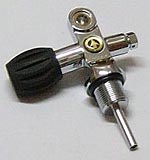 In the past, just as some cars used to have a "reserve switch" to access a bit of extra gas in the tank, some valves used a spring-loaded "reserve" system with a lever. Once pressure fell below a certain point, breathing resistance went up, alerting the diver to a low air situation. The lever would then be pulled to make the remaining air reserve available. Those valves were called "J-Valves." They have largely been replaced by pressure gauges and "K-Valves." These have just one outlet that is used both for filling and for connecting to the regulator. There are valves with two outlets. The valve shown on the right is a KV-5 from AmScuD. In the past, just as some cars used to have a "reserve switch" to access a bit of extra gas in the tank, some valves used a spring-loaded "reserve" system with a lever. Once pressure fell below a certain point, breathing resistance went up, alerting the diver to a low air situation. The lever would then be pulled to make the remaining air reserve available. Those valves were called "J-Valves." They have largely been replaced by pressure gauges and "K-Valves." These have just one outlet that is used both for filling and for connecting to the regulator. There are valves with two outlets. The valve shown on the right is a KV-5 from AmScuD.
On the regulator side, tank valves can be either of the yoke type or have a DIN screw fitting.
Yoke types are much more common in the United States, but DIN fittings can
handle higher pressure, generally 4,500 psi. The thread count of DIN valves can vary with the pressure rating of the tank. Oh, and "DIN" stands for Deutsche Industrie Norm," a German standard for metric measurements. Adapters between yoke and DIN fittings exist.
General rules
There are a number of general, common-sense rules and guidelines when dealing with scuba cylinders.
- Don't overfill them. If the "+" indictor is stamped on a steel tank, 10% over the rated pressure is okay. Aluminum cylinders must never be overfilled.
- Don't totally empty a cylinder during a dive. A bit of remaining pressure inside keeps moisture (and thus increased likelihood of corrosion) out.
- Have all inspections, tests, and repair work done by formally trained and certified technicians.
- Personally inspect your cylinder before every dive.
- Store cylinder upright with 300 to 500 psi of pressure in them.
- However, NEVER leave a charged cylinder standing and then walk away!
- Once your equipment is hooked up to the tank, always lay the tank down first, with the gear on top.
- Remove the cylinder boot periodically to see if corrosion formed underneath.
- Handle cylinders carefully so they don't drop. Hold on to the valve or body, not straps or netting.
- Maintain the "O" rings.
- After diving, when you removed the regulator, partially open the tank valve to blow out droplets that may accumulate.
- Fill slowly so the tank doesn't heat up too much.
- Keep the tank away from heat as much as possible.
- Never use an aluminum tank that has heated up to over 350F. It will no
longer be structurally sound.
Are tanks fashion accessories?
No. We'll leave that role to fins, snorkels and dive suits. But you still find scuba tanks in all sorts of attractive colors. That's cool but for a while now regulatory agencies have been urging manufacturers to use color coding for the tank's shoulder (the top of the cylinder close to the pillar valve) as follows:
- Air: white and black quartered shoulder
- Nitrox: White and black quartered shoulder
- Heliox: White and brown quartered shoulder
- Trimix: White, black and brown segmented shoulder
- Pure Oxygen: White shoulder
- Pure helium: Brown shoulder
In Europe, cylinders must also be clearly marked in writing with what gas or mix is
inside.
How big a tank do I need?
As stated above, rental tanks are usually 80 cu-ft, with 100 cu-ft occasionally available for more bottom time. But how long will the air in a given size tank last? That depends on two factors: First, how much air a diver consumes, and second, at what depth the air is being consumed. An average diver will use about a cubic foot of air per minute. Under exertion, that can go up considerably. The ambient pressure compresses the air, which
means it gets used up quicker. At a depth of 33 feet, air is already compressed to half. The quantity of gas consumed therefore is:
Breathing rate x pressure x time
So if a diver's breathing rate is a cubic foot per minute and the tank contains 80 cu-ft, the tank lasts 80 minutes at the surface. The formula would show:
1 cu-ft/minute x 1 bar pressure x 80 minutes = 80 cu-ft.
Now let's go down to 33 feet where the pressure is 2 bar:
1 cu-ft/minute x 2 bar pressure x 40 minutes = 80 cu-ft.
Which means that, everything else being equal, the tank only lasts half as long.
There are also other considerations. Weight and length of a tank can be big issues if you have to carry it around. Depending on the kind of diving you do, the extra size and weight of a large tank may not be worth the few minutes of extra dive time. Sometimes it's little things. For example, it may be easy to carry two short tanks by their necks, but you need to lift up longer tanks so they don't drag on the ground, making it much harder to move them around.
Tank accessories
As with almost every other piece of scuba equipment, there are accessories that can be used with tanks. Among them are:
Sleeves - netting that protects the tank from abrasion and scratches.
Attachments - to make it easy to carry or roll the cylinder out of the water.
Boots - made of rubber or plastic, boots let you store steel cylinders (which have rounded bottoms) upright. These are pretty much mandatory.
Battery packs - to power underwater lights and such.
|
